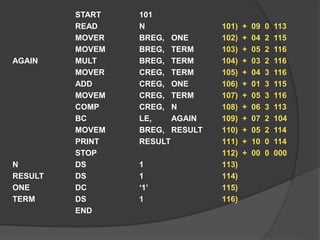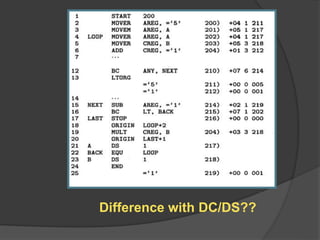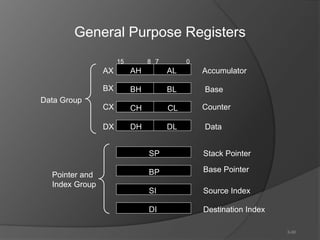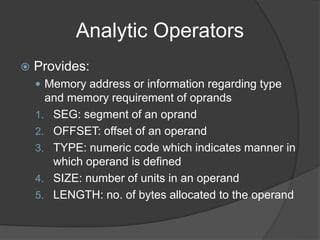Ch 3 Assembler in System programming
- 2. Assembly language Machine dependant Low level programming language
- 3. App Domain Execution Domain Semantic Gap Link with Chapter-1
- 5. Mnemonic operation code Data declarations Symbolic Operands No need to memorize numeric operation codesMemory bindings to these names by assembler Avoids manual conversi on
- 6. START 101 READ N MOVER BREG, ONE MOVEM BREG, TERM AGAIN MULT BREG, TERM MOVER CREG, TERM ADD CREG, ONE MOVEM CREG, TERM COMP CREG, N BC LE, AGAIN MOVEM BREG, AGAIN PRINT RESULT STOP N DS 1 RESULT DS 1 ONE DC ‘1’ TERM DS 1 END 101) + 09 0 113 102) + 04 2 115 103) + 05 2 116 104) + 03 2 116 105) + 04 3 116 106) + 01 3 115 107) + 05 3 116 108) + 06 3 113 109) + 07 2 104 110) + 05 2 114 111) + 10 0 114 112) + 00 0 000 113) 114) 115) + 00 0 001 116)
- 7. Statement Format Label Opcode Operand specification , Operand Specification OptionalOptional
- 8. A simple assembly language Statement Operand1 Operand2 I am always a register..!!! I am always a symbolic name..!!!
- 9. MOVER and MOVEM MOVEM MOVER MOVEM Source , Dest MOVER Dest , Source
- 11. Mnemonic Operation Codes Instruction Opcode Assembly Mnemonic Remarks 00 STOP Stops execution 01 ADD First operand is 02 SUB Modified 03 MULT 04 MOVER Register memory move 05 MOVEM Memory register move 06 COMP Sets condition code 07 BC Branch on Condition 08 DIV Analogous to SUB 09 READ Performs reading and 10 PRINT printing
- 12. Syntax for BC BC Memory Address Condition code LT, LE, EQ, GT, GE, ANY
- 13. Machine instruction format and example Sign(1) Opcode(2) Reg Operand(1) Memory Operand(3)
- 14. START 101 READ N MOVER BREG, ONE MOVEM BREG, TERM AGAIN MULT BREG, TERM MOVER CREG, TERM ADD CREG, ONE MOVEM CREG, TERM COMP CREG, N BC LE, AGAIN MOVEM BREG, RESULT PRINT RESULT STOP N DS 1 RESULT DS 1 ONE DC ‘1’ TERM DS 1 END 101) + 09 0 113 102) + 04 2 115 103) + 05 2 116 104) + 03 2 116 105) + 04 3 116 106) + 01 3 115 107) + 05 3 116 108) + 06 3 113 109) + 07 2 104 110) + 05 2 114 111) + 10 0 114 112) + 00 0 000 113) 114) 115) 116)
- 15. Imperative Assembler directivesDeclaration An action to be performed during executionFor declaring constants or assigning value Instructs the assembler to perform certain actions
- 16. Declaration Statements • Reserves area of memory and associates names with them • Example : A DS 1 DS (Declare Storage) • Construct memory words containing constants • ONE DC ‘1’ DC (Declare constant)
- 17. What is the use of constants? DC doesn’t really implement the constants because… These values are not protected by assembler They may be changed by moving the new value in that memory word. ONE DC ‘1’ MOVEM BREG,ONE
- 18. Similarities with the implementation of constants in HLL 1. Immediate Operands 2. literals
- 19. 1. A constant as immediate operand ADD AREG,5 Our assembly language doesn’t support this..!! ADD AREG,FIVE ---- FIVE DC ‘5’ How to write equivalent instructions for this??
- 20. 2. Literal Operand with syntax = ‘ value ’ What is the Difference between literal and constant..?? ??? ?? The location of a literal cant be specified. So its value cant be changed like constant… ADD AREG, =‘5’
- 21. 2. Literal What is the Difference between literal and immediate operand..?? ??? ?? No Architectural provision is needed for literal like immediate operand.. ( Literal ) ADD AREG, =‘5’ ( Imm. operand ) ADD AREG,5
- 22. Assembler Directives 1. START <constant> 2. END [<op spec>] The first word of the target program should be placed in the memory word with the address specified.. Indicates the end of the source program..
- 24. START 101 READ N MOVER BREG, ONE MOVEM BREG, TERM AGAIN MULT BREG, TERM MOVER CREG, TERM ADD CREG, ONE MOVEM CREG, TERM COMP CREG, N BC LE, AGAIN MOVEM BREG, RESULT PRINT RESULT STOP N DS 1 RESULT DS 1 ONE DC ‘1’ TERM DS 1 END 101) + 09 0 113 102) + 04 2 115 103) + 05 2 116 104) + 03 2 116 105) + 04 3 116 106) + 01 3 115 107) + 05 3 116 108) + 06 3 113 109) + 07 2 104 110) + 05 2 114 111) + 10 0 114 112) + 00 0 000 113) 114) 115) 116)
- 25. START 101 READ N MOVER BREG, ONE MOVEM BREG, TERM AGAIN MULT BREG, TERM MOVER CREG, TERM ADD CREG, ONE MOVEM CREG, TERM COMP CREG, N BC LE, AGAIN DIV BREG, TWO MOVEM BREG, RESULT PRINT RESULT STOP N DS 1 RESULT DS 1 ONE DC ‘1’ TERM DS 1 TWO DC ‘2’ END 101) + 09 0 114 102) + 04 2 116 103) + 05 2 117 104) + 03 2 117 105) + 04 3 117 106) + 01 3 116 107) + 05 3 117 108) + 06 3 114 109) + 07 2 104 110) + 08 2 118 111) + 05 0 115 112) + 10 0 115 113) + 00 0 000 114) 115) 116) 117) 118)
- 26. Advantages of assembly language Machine language program needs to be changed drastically if we modify the original program. It is more suitable when it is desirable to use specific architectural features of a computer… Example – special instructions supported by CPU
- 27. Design Specification of assembler Identify the information necessary to perform the task Design the suitable data structures to record the information Determine the processing necessary to obtain and manage the information Determine the information necessary to perform the task
- 28. Example Which information do we need to convert this instruction in to the equivalent machine language instruction??? MOVER BREG, ONE 1. Address of the memory word for ONE 2. Machine Operation code for MOVER
- 29. 2. Machine Operation code for MOVER 1. Address of the memory word for ONE Depends on the source program..!! Doesn’t depend on the source program..!!
- 30. Data structure required.. Name Address Mnemonic Opcode Built by the analysis phase… Used during the synthesis phase…
- 31. Two phases of assembler 2. Synthesis 1. Analysis
- 32. Analysis phase Main Task : Building of Symbol table For this, it must determine the address with which the symbolic names are associated To determine the address of a particular symbolic name, we must fix the address of all elements preceding it Memory allocation..
- 33. Data structure to implement Memory allocation Location Counter Contains the address of the next mem. word initialized to constant in START Whenever there is a label, it enters the Label and LC contents in the new entry of symbol table Name Address AGAIN 104
- 34. Cont… After this, it finds the number of mem words required by that statement and again updates the LC content It needs to know the length of instructions.! Depends on assembly lang. Processing involved in maintaining LC LC Processing
- 35. Data structure of the assembler
- 36. ADD 01 1 SUB 02 1 AGAIN 104 N 113 Analysis phase Synthesis phase mnemonic op code length Source Program Target Program Mnemonics table Symbol table symbol address
- 37. Tasks of analysis phase 1. Separate label, opcode & operand 2. Build the symbol table 3. Perform LC processing 4. Construct IC Analysis
- 38. Tasks of analysis phase 1. Obtain the machine opcode corresponding to the mnemonic 2. Obtain the address of a memory operand from symbol table 3. Synthesize the machine instruction Synthesis
- 39. Pass structure of Assembler 2. Two pass assembler 1. Single Pass Assembler
- 40. Two pass assembler 1st Pass Performs analysis 2nd Pass Performs synthesis
- 42. Pass 1 Pass 2 Source Program Target Program Data Structures Intermediate Code
- 43. Design of a two pass assembler 1. Separate label, opcode & operand 2. Build the symbol table 3. Perform LC processing 4. Construct IC 1st pass
- 46. Single Pass translation Problem of Forward reference Handled by Process called Back patching
- 47. START 101 READ N MOVER BREG, ONE MOVEM BREG, TERM AGAIN MULT BREG, TERM MOVER CREG, TERM ADD CREG, ONE MOVEM CREG, TERM COMP CREG, N BC LE, AGAIN MOVEM BREG, AGAIN PRINT RESULT STOP N DS 1 RESULT DS 1 ONE DC ‘1’ TERM DS 1 END 101) + 09 0 113 102) + 04 2 115 103) + 05 2 116 104) + 03 2 116 105) + 04 3 116 106) + 01 3 115 107) + 05 3 116 108) + 06 3 113 109) + 07 2 104 110) + 05 2 114 111) + 10 0 114 112) + 00 0 000 113) 114) 115) 116)
- 48. Back patching The operand field of an instruction is containing forward reference is kept blank initially. The address of that symbol is put into field when its address is encountered.
- 49. Back patching Table of Incomplete Instruction (TII) Instruction address Symbol 101 ONE
- 50. After the END statement is processed… Symbol Table Addresses of all the symbols defined in prog TII Information of all forward references
- 51. Back patching The assembler can now process each entry in TII to complete the concerned instruction. Example – (101,ONE) 1. Obtain the Address of ONE from the symbol table 2. Insert It into the instruction at location 101
- 53. ORIGIN ORIGIN < Address Specification > 2. constant 1. Operand Specification ORIGIN LAST+1 ORIGIN 217
- 54. Cont… It is useful when your target program does not consist of consecutive memory words. Operand Specification – Ability to perform Relative LC Processing, not absolute. Difference between using both the options
- 56. EQU Defines the symbol to represent <add spec> Symbol EQU < address specification > 2. constant 1. Operand Specification BACK EQU LOOP BACK EQU 200
- 58. Literal, why LTORG? ADD AREG, =5 ADD AREG,FIVE ---- FIVE DC ‘5’ What is done internally by assembler?
- 59. LTORG Allows programmer to specify where literals should be stored.
- 60. What if we don’t write LTORG?
- 61. Pass -1 of the Assembler • Table of mnemonic opcodes and its classOPTAB • Contains symbol name, addressSYMTAB • Table of literals used in the programLITTAB
- 62. OPTAB Contains 1. mnemonic opcode 2. class 3. mnemonic information 2. Class IS (Imperative) DS (Declarative) AD
- 63. 2.Class IS DS AD 3. Mnemonic info (Machine Opcode, Inst Length) 3. Mnemonic info ID of a routine
- 64. OPTAB
- 65. SYMTAB
- 66. LITTAB Contains two fields. 1. Literal 2. Address
- 67. POOLTAB
- 68. Intermediate Code Format Address Opcode Operands
- 69. Opcode format (Statement Class, Code)
- 70. Operand Specification (Operand Class, Code) Class C (Constant) L (Literal) S (symbol)
- 72. PASS-1 Algorithm
- 76. Variants of IC
- 77. Variant - 2 of IC
- 78. Variant-2 of IC
- 79. Variants of IC Extra work in Pass I Simplified Pass II Pass I code occupies more memory than code of Pass II Does not simplify the task of Pass II or save much memory in some situation. IC is less compact Memory required for two passes would be better balanced So better memory utilization
- 80. Processing of Declarations & Assembler Directives Is it necessary to represent the address of each source statement in the intermediate code? Is it necessary to have a represent of DS statements and assembler directives in the intermediate code?
- 82. PASS – 2 of assembler
- 85. Error Reporting
- 87. Single pass Assembler for Intel x86
- 88. Some organizational issues Tables Source Program and intermediate code
- 89. 3-90 General Purpose Registers 15 8 7 0 AX BX CX DX AH AL BH BL CH CL DH DL Accumulator Base Counter Data SP BP SI DI Data Group Pointer and Index Group Stack Pointer Base Pointer Source Index Destination Index
- 91. Segment Registers Program may consist of many segments. Each segment may contain a part of programs code, data or stack. Instruction uses segment register and 16bit offset to Address memory operand. Each segment is of size 64Kbytes.
- 92. Addressing Modes Addressing Mode Example Remarks Immediate MOV SUM, 1234H Data=1234H Register MOV SUM, AX AX contains the data Direct MOV SUM,[1234H] Data disp.=1234H RegisterIndirect MOV SUM, [BX] Data disp.= (BX) Register Indirect MOV SUM,CS:[BX] Segment override: Segment base: CS Data disp.:(BX) Based MOV SUM,12H[BX] Data disp. =12H +(BX) Note: we can use BX or BP BX: Data segment BP: stack segment Indexed MOV SUM,34H[SI] Data disp. =12H +(SI) Note: we can use DI or SI Based and indexed MOV SUM,56H[SI][BX] Data disp.= 56H + (SI)+(BX)
- 93. Instruction Formats of Intel 8088 • mod and r/m fields specify the first operand • reg field specify second operand • opcode indicates which instruction format is applicable • d indicates which operand is the destination operand • w indicates whether 8 or 16 bit arithmetic is to be used
- 94. r/m Mod=00 Mod=01 Mod=10 W=0 W=1 000 (BX)+(SI) (BX)+(SI)+d8 NOTE2 AL AX 001 (BX)+(DI ) (BX)+(DI) +d8 NOTE2 CL CX 010 (BP)+(SI) (BP)+(SI) +d8 NOTE2 DL DX 011 (BP)+(DI ) (BP)+(DI) +d8 NOTE2 BL BX 100 (SI) (SI) +d8 NOTE2 AH SP 101 (DI) (DI) +d8 NOTE2 CH BP 110 NOTE3 (BP) +d8 NOTE2 DH SI 111 (BX) (BX) +d8 NOTE2 BH DI Note1: d8 denotes an 8-bit displacement Note2: same as in the previous column , except d18 instead of d8 Note3: (BP)+DISP for indirect addressing, d16 for direct First operand Its value can be in a register or in memory.
- 95. reg Register 8 bit (w=0) 16 bit (w=1) 000 AL AX 001 CL CX 010 DL DX 011 BL BX 100 AH SP 101 CH BP 110 DH SI 111 BH DI Second operand
- 96. Segment overrides Seg Segment Register 00 ES 01 CS 10 SS 11 DS • By Dedfault arithmetic and MOV instruction uses the Data Segment • To use other segment, an instruction has to be preceded by 1 byte : Segment override prefix Its format is: 001 seg 110 Example: ADD AL, CS:12H[SI]
- 98. Statement Format [Lable:] Opcode Operand(s) ; Comment
- 99. Assembler Directives ORG EQU END Same as ORIGIN, EQU, and END respectively LTORG: Is not used as 8088 supports immediate addressing PURGE SEGMENT ENDS ASSUME
- 100. PURGE Name defined usin EQU can be ‘undefined’ through this directive Example: XYZ DB ? ABC EQU XYZ ;ABC represents the name xyz PURGE ABC ;ABC no longer represents XYZ ABC EQU 25 ;ABC now represents the value 25
- 101. SEGMENT and ENDS SEGMENT : Indicate beginning of a segment ENDS: Indicate end of a segment
- 102. ASSUME Informs assembler that the address of the indicated segment would be present in <segment register> SYNTAX: ASSUME <Segment register> : <Segment name> To nullify the effect of previous ASSUME ASSUME <register> :NOTHING
- 103. EXAMPLE
- 104. Other Directives PROC and ENDP: it delimits the body of procedure. NEAR and FAR: Indicate call to aprocedure is a near or a far call
- 105. PUBLIC and EXTERN Normally, symbol declared in one program can be use only from within that program Use PUBLIC directive : if the symbol is to be accessed in other program Use EXTERN directive: If any other program wishing to use the symbol. EXTERN <symbolic name> : <type>
- 106. Declarations DB- Reserve a byte and initialize it Example: A DB 25 DW - Reserve a word, but do not initialize Example: B DW ? • DW - Reserve & initialize word to A’s offset Example: ADD_A DW A DD – Double words, all initialized to 0s • Example: C DB 6DUP(0)
- 107. Declarations DQ and DT reserve and initialize quad-word (area of 8 bytes) whose start address is aligned on a multiple of 8 or 10 bytes respectively.
- 108. Analytic Operators Provides: Memory address or information regarding type and memory requirement of oprands 1. SEG: segment of an oprand 2. OFFSET: offset of an operand 3. TYPE: numeric code which indicates manner in which operand is defined 4. SIZE: number of units in an operand 5. LENGTH: no. of bytes allocated to the operand
- 109. Code Operand type 1 Byte 2 Word 4 Double word 8 Quad word 10 Ten bytes -1 Near instruction -2 Far instruction Example: MOV AX,OFFSET ABC BUFFER DW 100 DUP (0) MOV CX, LENGTH XYZ
- 110. Synthetic operator PTR: defines a new memory operand that has same segment and offset with different data type THIS: it defines new memory operand to have the same address as the next byte in the program
- 111. Problems of Single Pass Assembly Forward references: Symbol is used as a data operand ○ Solution: TII(table of incomplete instructions) Symbol is used as the destination address ○ Solution: use keyword SHORT to indicate short displacement Use of Segment registers: Store pair (segment register, segment name) in Segment register table(SRTAB) for statement: ASSUME <segment register> : <segment name>
- 113. Problems of Single Pass Assembly Provisions: 1. A new SRTAB is created when an ASSUME statement is encountred. It differs from old SRTAB only in entries for the segment registers named in the ASSUME statement. Many SRTABs may exist at any time. SRTAB_ARRAY is used to store SRTABs.
- 114. Problems of Single Pass Assembly2. Instead of using TII, forward reference table (FRT) is used. Each entry of FRT contains: a) Address of the instruction b) Symbol to which forward reference is made c) Kind of reference • T : Analytic operator TYPE • D : Data Address • S : Self Relative Address • L : length • F : offset d) Identity of the SRTAB that should be used for assembling the reference.
- 115. Mnemonic Table and Symbol Table
- 116. Segment Register Table Array
- 117. FRT and CRT
- 118. Example
- 119. Example
- 120. Algorithm Data structures used by algo: SYMTAB, SRTAB_ARRAY, CRT, FRT and ERRTAB LC :Location counter code_area :Area of Assembling the target program code_area_address :contains address of code_area srtab_no :number of the current SRTAB stmt_no : number of the current statement SYMTAB_segment_entry : SYMTAB entry # of current segment machine_code_buffer :area for constructing code for one statement
- 121. Algorithm
- 122. Algorithm
- 123. Algorithm
- 126. Error reporting
- 127. Thank you





















![Assembler Directives
1. START <constant>
2. END [<op spec>]
The first word of the
target program should
be placed in the
memory word with the
address specified..
Indicates
the end of
the source
program..](https://image.slidesharecdn.com/ch3assembler-170518162719/85/Ch-3-Assembler-in-System-programming-22-320.jpg)





































































![Addressing Modes
Addressing
Mode
Example Remarks
Immediate MOV SUM, 1234H Data=1234H
Register MOV SUM, AX AX contains the data
Direct MOV SUM,[1234H] Data disp.=1234H
RegisterIndirect MOV SUM, [BX] Data disp.= (BX)
Register Indirect MOV SUM,CS:[BX] Segment override:
Segment base: CS Data
disp.:(BX)
Based MOV SUM,12H[BX] Data disp. =12H +(BX)
Note: we can use BX or BP
BX: Data segment BP: stack
segment
Indexed MOV SUM,34H[SI] Data disp. =12H +(SI)
Note: we can use DI or SI
Based and
indexed
MOV
SUM,56H[SI][BX]
Data disp.= 56H + (SI)+(BX)](https://image.slidesharecdn.com/ch3assembler-170518162719/85/Ch-3-Assembler-in-System-programming-92-320.jpg)



![Segment overrides
Seg Segment
Register
00 ES
01 CS
10 SS
11 DS
• By Dedfault arithmetic and MOV instruction uses the Data
Segment
• To use other segment, an instruction has to be preceded by 1
byte :
Segment override prefix
Its format is: 001 seg 110
Example: ADD AL, CS:12H[SI]](https://image.slidesharecdn.com/ch3assembler-170518162719/85/Ch-3-Assembler-in-System-programming-96-320.jpg)

![Statement Format
[Lable:] Opcode Operand(s) ; Comment](https://image.slidesharecdn.com/ch3assembler-170518162719/85/Ch-3-Assembler-in-System-programming-98-320.jpg)




























